Lump comfrey
| Lump comfrey | ||||||||||||
|---|---|---|---|---|---|---|---|---|---|---|---|---|

Lump comfrey ( Symphytum tuberosum ) |
||||||||||||
| Systematics | ||||||||||||
|
||||||||||||
| Scientific name | ||||||||||||
| Symphytum tuberosum | ||||||||||||
| L. |
The knotted comfrey ( Symphytum tuberosum ), more rarely known as knotty wallwort , is a type of plant from the genus comfrey ( Symphytum ) within the predatory family (Boraginaceae). Other common names are Knollen-Beinwell and Knolliger Beinwell, which are also used as a name for the closely related species Symphytum bulbosum . With its pale yellow flowers, the knot comfrey resembles the light-flowered forms of the real comfrey , but is considerably smaller and hardly branched.
description
Vegetative characteristics
The knot comfrey grows as a perennial herbaceous plant that reaches heights of 20 to 30 centimeters. A slightly branched, bulbous rhizome is formed as a survival organ . The stem hardly branches. The aboveground parts of the plant are coarsely hairy. The lower leaves are ovate and narrow into a petiole; the upper ones are seated and only half, narrowly sloping down.
Generative characteristics
The flowering period extends from April to May. Usually six to ten flowers are arranged in a double coil . From the otherwise very similar tuber comfrey ( Symphytum bulbosum ), the node comfrey mainly differs in its larger flowers. The yellowish-white flowers are funnel-shaped and tubular and have five corolla lobes that are curved back. The corolla lobes are 15 to 20 millimeters long in the tuberous comfrey, only 7 to 11 millimeters in the tuberous comfrey and, unlike in the tuberous comfrey, they protrude over the pharynx.
The partial fruits are more or less rough and reticulate-wrinkled.
The number of chromosomes is 2n = 18, 64, 72, 96, 100 or 128.
use
In medicine, the knot comfrey is used similarly to many other types of comfrey (see real comfrey ).
The rhizome is starchy, it was ground in times of need and bread dough was mixed in. If you roast the rhizome until it is brown and then grind it, the powder can replace coffee; it has a smoothness in taste that cannot be found in real coffee.
Occasionally, the knotted comfrey is used as a ground cover in gardens as an ornamental plant .
Occurrence
Knot comfrey is common in western, central and southern Europe. In the north it reaches the British Isles, in the east Ukraine and in the southeast Turkey. It has also become naturalized in parts of the USA through garden refugees. In Germany, the common comfrey grows mainly in the central and southern part of Bavaria east of the Lech , and also in northern Germany on the Elbe and Oder . As a location, it prefers shady to partially shaded places in nutrient-rich deciduous and mixed forests. He is a Fagetalia order character. In Austria it is only missing in the federal state of Vorarlberg .
Systematics
The first publication of Symphytum tuberosum was done by Carl von Linné . The specific epithet tuberosum is derived from the sometimes bulbous "root stock", meaning the rhizome.
From Symphytum tuberosum there are at least two subspecies:
- Symphytum tuberosum subsp. angustifolium (Kern.) Nyman ( Syn .: Symphytum nodosum Schur , Symphytum tuberosum subsp. nodosum (Schur) Soó , Symphytum leonhardtianum Pugsley ): It occurs from France , Germany and Switzerland through all of Southeastern and Eastern Europe to Turkey .
- Symphytum tuberosum L. subsp. tuberosum (Syn .: Symphytum mediterraneum W.DJKoch , Symphytum tuberosum subsp. mediterraneum (WDJKoch) P.Fourn. , Symphytum minus Bubani nom. illeg.)
swell
literature
- Erich Oberdorfer : Plant-sociological excursion flora . With the collaboration of Theo Müller. 7th, revised and expanded edition. Eugen Ulmer, Stuttgart (Hohenheim) 1994, ISBN 3-8252-1828-7 .
Individual evidence
- ↑ a b Erich Oberdorfer : Plant-sociological excursion flora for Germany and neighboring areas . With the collaboration of Angelika Schwabe and Theo Müller. 8th, heavily revised and expanded edition. Eugen Ulmer, Stuttgart (Hohenheim) 2001, ISBN 3-8001-3131-5 , pp. 788 .
- ↑ a b c d Benito Valdés, 2011: Boraginaceae. : Datasheet Lycopsis arvensis In: Euro + Med Plantbase - the information resource for Euro-Mediterranean plant diversity.
- ^ Manfred A. Fischer, Karl Oswald, Wolfgang Adler: Excursion flora for Austria, Liechtenstein and South Tyrol . 3rd, improved edition. Province of Upper Austria, Biology Center of the Upper Austrian State Museums, Linz 2008, ISBN 978-3-85474-187-9 , p. 695 .
Web links
- Symphytum tuberosum L., lump comfrey. In: FloraWeb.de.
- Symphytum tuberosum L. In: Info Flora , the national data and information center for Swiss flora . Retrieved February 10, 2016.
- Thomas Meyer: Comfrey data sheet with identification key and photos at Flora-de: Flora von Deutschland (old name of the website: Flowers in Swabia ).
- Data sheet with photos of the "Knollen-Comfrey" - Symphytum tuberosum at Botanik im Bild / Flora von Österreich , 2004.
- Symphytum tuberosum at Plants For A Future

